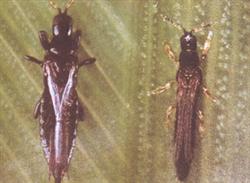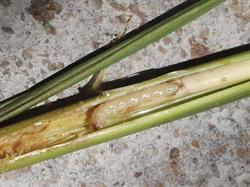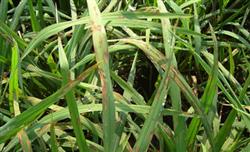Rice diseases and insect pests: how to control common rice diseases and insect pests?

How to control common rice diseases and insect pests? Please introduce and guide how to control common rice diseases and insect pests: Rice thrips, leaf rollers (rice bracts), rice leaf borer, rice planthopper. Detailed control methods can be referred to the following methods: first, rice thrips rice thrips are very small, adults are dark brown, winged, crawling very fast. Life is divided into three stages: egg, nymph and adult. Similar to adults, nymphs are yellowish, small, wingless, often curled at the tip of rice leaves, and suck up the sap of rice leaves. The killed rice leaves lose water and curl, the rice seedlings turn yellow, there are dots of white spots on the rice leaves, and the heart leaves shrink, which looks like burning from a distance. Control methods of rice thrips during flowering. Because the rice thrips are very small, in general, they are not easy to attract people's attention, and they are only found when the rice is seriously damaged and cause a large number of rolled leaves. Therefore, it is necessary to check in time to eliminate the rice thrips in the larval stage. Use 40% dimethoate emulsion 1500-2000 times per mu, and keep the water layer after application in seedling fields and fields. After the control of rice thrips, quick-acting fertilizer should be applied to promote the growth of seedlings and tillers. 2. Brown gray planthopper and back planthopper are the most harmful to rice planthopper. The rice planthopper generally hides in the leaf sheath and stem tissue of the lower part of the rice plant in the middle of the rice field, sucking the sap of the rice stem, and irregular long brown spots appear in the damaged part of the rice plant. in severe cases, the base of the rice plant turns dark brown. Due to the destruction of stem tissue, nutrients can not rise, rice plants gradually withered and withered, or lodging. After heading, the lower rice stem is senescent, and the rice planthopper transfers the upper part to absorb the tender panicle neck, so that the rice grain becomes empty shell or semi-full grain. At the same time, gray planthopper can spread rice virus disease. Prevention and control methods 1. Drop oil to kill insects. Drop 400 grams of waste diesel oil or waste engine oil per mu, keep a shallow water layer of 20 cm in the field, manually drive out insects, insects fall into the water and touch the oil and die. Change clear water after treatment, do not use this method after booting. two。 Sow poison. Sprinkle with 1.5 kg dimethoate powder and 2 kg moist fine soil per mu. 3. Spray with 40% dimethoate emulsion 0.5 kg plus water 800-1000 kg. Rice bract insect, also known as curly leaf worm, often occurs once a few years, resulting in a substantial reduction in rice production. The adults are reddish brown butterflies, and the larvae harm rice. After the rice leaves are killed, they are broken and broken. In serious cases, only veins are left, and the rice bushes are like brushing pot brooms. Especially after the rice was killed at the booting stage, the larvae silked the rice leaves together to form the curl of the rice ear and could not produce the ear, which affected the yield. Prevention and control methods 1. Use 2.5% trichlorfon powder 2 kg spray powder or methyl 6 powder 1 kg fine soil 10 kg poisonous soil per mu. two。 Use 90% crystal trichlorfon 150 g plus water 80g 100kg spray. Fourth, the rice leaf roller larvae begin to spin silk in the heart leaves of rice, rolling both sides of the leaves into tubular bracts, and the insects hide in the bracts to feed on the mesophyll and upper epidermis, and endanger them in the tender leaf sheaths after heading. In severe cases, the rolled leaves only have transparent and whitish epidermis, and the whole leaves die. The control method was sprayed with 25% 223 emulsion 250 times and 90% trichlorfon 1000-1500 times. The control time should be controlled before the third instar of the larvae, and the effect of medication in the evening is the best. After prevention and treatment, the effect should be checked, and if the population density is the same as before, it should be treated again. Click to get more rice planting techniques click to get more food crop planting techniques
- Prev

Rice diseases and insect pests: how to treat rice heart-drilling insects?
How to treat rice heart-drilling worm? Please introduce the control methods in detail. You can refer to the following methods for control: first, update rice varieties: compress or eliminate a small number of varieties that are particularly susceptible to insects, so as to reduce the pressure and occurrence of chemical control. Second, killing pupae by flooding: due to the harm of Chilo suppressalis.
- Next

Rice cultivation: how to control diseases and insect pests in the middle and later stages of rice?
How to control diseases and insect pests in the middle and later stage of rice? Please introduce in detail the methods for the control of rice diseases and insect pests in the middle and later stages, including rice blast, bacterial leaf blight, stem borer and planthopper, which can be controlled with reference to the following methods: (1) the control of rice blast is at the jointing and tillering stage of rice, when the central diseased plant appears in the field (early July).
Related
- The first cup of black tea in spring, the flavor and history of tea gardens in Kenya, Africa
- The computer can not only choose potatoes, but also grow tea rice. AI will grow winter oolong tea champion.
- It is not only the inflated tea bitten by insects, but also engraved with the four seasons tea in Beipu.
- The Oriental Beauty Tea Festival in Zhuxian County takes the stage at the weekend to experience the plus-size feast of oil tea.
- & quot; Oriental Beauty Tea & Exploration of Emei in Hsinchu, the hometown of quot;
- The new variety of strawberry "Tainong 1" dessert is the first choice with mellow aroma. Crimson gorgeous
- History of Tea in Taiwan: from Wild Inner Mountain to Export Tea Garden
- Two types of Taiwan Oriental Beauty Black Tea won the British three-Star Award for Childhood Tea Xiang Zhang Jiaqi changed from pilot to champion tea maker.
- Banana species and varieties: the planting history of Taiwan Xianren banana and dwarf banana is long, is banana disease resistant?
- Coffee planting Technology: Qianjie Coffee from Seedling to harvesting

